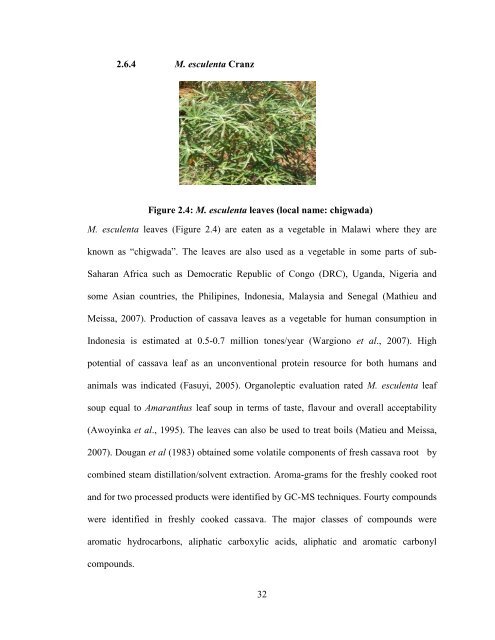a study of the quality of a local herbal tea and volatiles of parinari ...
a study of the quality of a local herbal tea and volatiles of parinari ...
a study of the quality of a local herbal tea and volatiles of parinari ...
You also want an ePaper? Increase the reach of your titles
YUMPU automatically turns print PDFs into web optimized ePapers that Google loves.
2.6.4 M. esculenta Cranz<br />
M. esculenta leaves (Figure 2.4) are eaten as a vegetable in Malawi where <strong>the</strong>y are<br />
known as “chigwada”. The leaves are also used as a vegetable in some parts <strong>of</strong> sub-<br />
Saharan Africa such as Democratic Republic <strong>of</strong> Congo (DRC), Ug<strong>and</strong>a, Nigeria <strong>and</strong><br />
some Asian countries, <strong>the</strong> Philipines, Indonesia, Malaysia <strong>and</strong> Senegal (Mathieu <strong>and</strong><br />
Meissa, 2007). Production <strong>of</strong> cassava leaves as a vegetable for human consumption in<br />
Indonesia is estimated at 0.5-0.7 million tones/year (Wargiono et al., 2007). High<br />
potential <strong>of</strong> cassava leaf as an unconventional protein resource for both humans <strong>and</strong><br />
animals was indicated (Fasuyi, 2005). Organoleptic evaluation rated M. esculenta leaf<br />
soup equal to Amaranthus leaf soup in terms <strong>of</strong> taste, flavour <strong>and</strong> overall acceptability<br />
(Awoyinka et al., 1995). The leaves can also be used to treat boils (Matieu <strong>and</strong> Meissa,<br />
2007). Dougan et al (1983) obtained some volatile components <strong>of</strong> fresh cassava root by<br />
combined s<strong>tea</strong>m distillation/solvent extraction. Aroma-grams for <strong>the</strong> freshly cooked root<br />
<strong>and</strong> for two processed products were identified by GC-MS techniques. Fourty compounds<br />
were identified in freshly cooked cassava. The major classes <strong>of</strong> compounds were<br />
aromatic hydrocarbons, aliphatic carboxylic acids, aliphatic <strong>and</strong> aromatic carbonyl<br />
compounds.<br />
Figure 2.4: M. esculenta leaves (<strong>local</strong> name: chigwada)<br />
32


